The World's Most Endangered Vertebrate: The Devil's Hole Pupfish
The Devil's Hole Pupfish, Cyprinodon diabolis, is sometimes considered the world's most endangered vertebrate. The population numbers less than 200 members, a number which until very recently had been dropping rapidly every year, and only lives on a single stone shelf six feet long and thirteen feet wide- definitely the smallest natural habitat of any vertebrate on the planet.
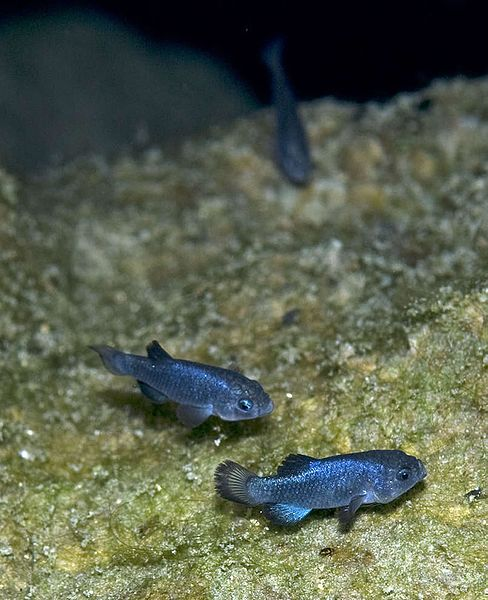
The Devil's Hole Pupfish. [Image source]
Devil's Hole is a deep, water filled cave in the Amargosa desert in Nevada. The limestone cave is at least 500 feet deep, but the bottom has never been mapped. While the pupfish have sometimes been discovered diving as deep as 80 feet, they spawn and forage for food entirely on the shallow, sunlit stone shelf. The little fish eat diatoms, for the most part.
Pupfish, for all that they're not the most beautiful fish around, are fascinating creatures. The name pupfish comes from the habits of their males at breeding time- they're said to behave in a playful fashion that resembles puppies. They're known for their ability to survive in extreme and isolated conditions. Cyprinodon diabolis is the smallest of the pupfish, along with being the rarest. They breed once a year in the spring, leading to a higher population every fall, which drops rapidly back down by the spring, as the parents all die off. (They only live a single year.) Interestingly, traumatic events seem to trigger off-season breeding. The big Alaskan quake at the beginning of 2018 was actually felt in Devil's Hole, causing seiche, waves produced when seismic waves travel through bodies of water that traditionally lack waves. This triggered an off-season breeding event among the pupfish. Reacting to an extreme event by breeding actually seems to be a sensible adaptation.
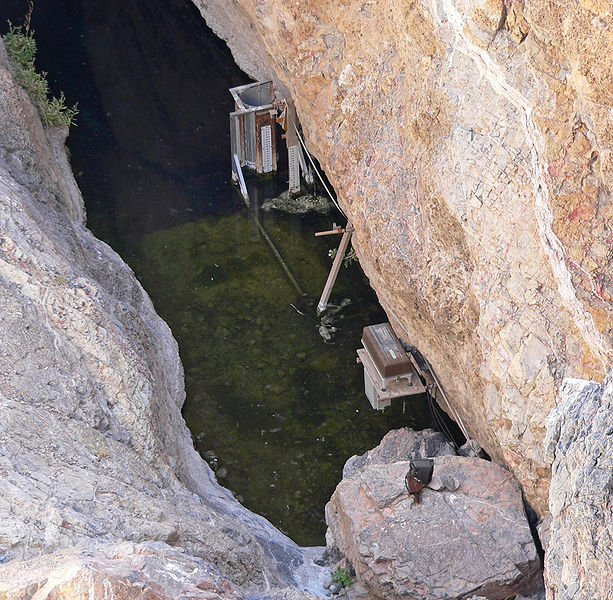
The entire natural range of the Devil's Hole Pupfish. [Image source]
Since they're the only fish in Devil's Hole, they don't face any threats from predation. Instead, habitat loss is the biggest threat they face. Prior to the 1990s, their population, though threatened, was considerably higher. The exact reason for the population loss is unknown, but lowering water levels due to agricultural use of regional groundwater is one possibility. Human interference in their habitat is another possibility- as much as a third of the population are believed to have been killed by scientific equipment washed into the hole by a flash flood in 2004. Three drunken tourists killed at least one pupfish, smashed a number of eggs, and damaged the shelf in April 2016. They now face felony charges after being identified.
The population has been partially restored by helping to feed the species. Captive populations have been established with some limited success, both as a hybridized version of the species and to a lesser extent the pure species. It turns out that Cyprinodon diabolis is simply too well adapted to Devil's Hole, to the point that they can't handle other environments well.
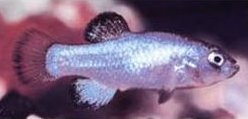
A closeup of the Devil's Hole Pupfish. [Image source]
Part of their extreme level of adaptation is due to the incredibly stable conditions in Devil's Hole. The geothermally heated water remains at a near constant 92 degrees Fahrenheit year round, is unusually oxygen poor, and the water is strongly alkaline. Since they live in such specific conditions, there isn't any particular incentive for them to be capable of adapting to different ones. They also, however, have what might be the highest mutation rate of any vertebrate species. Species with low populations tend to evolve and change faster, and the one year generations only exacerbate matters.. Mutations tend to spread much more quickly through small populations, and as such, Cyprinodon diabolis is thought to be weighted down with an extremely large number of harmful mutations, enough that very small changes in the environment are enough to threaten the population. The other effect of having a low population, of course, is making them much more vulnerable to extinction. (If you're interested in this, check out my post on island biogeography.
Interestingly, due to their absurdly high mutation rate, we don't know how long they've lived in Devil's Hole- it could be as little as 360 years, or as much as 60,000 years. Usually we can track the age of a species by comparing their mutation rate to that of a related species, but the mutation rate of Cyprinodon diabolis is just too high.
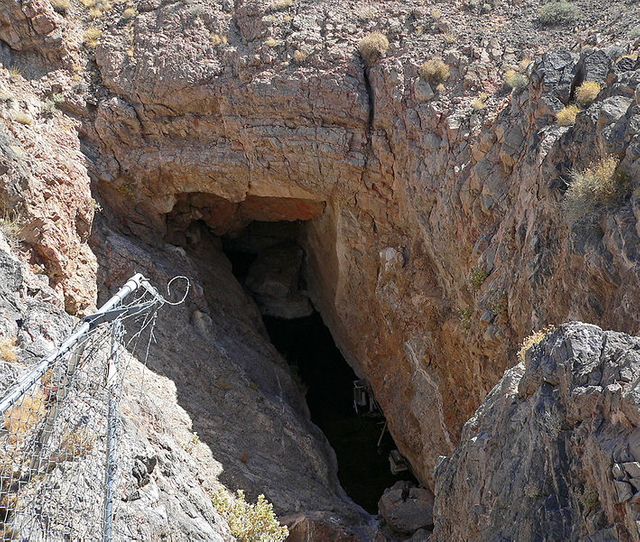
Devil's Hole. [Image source]
There are some interesting ethical questions involved in dealing with Cyprinodon diabolis. We've gone to some rather extreme efforts to preserve an isolated species that isn't part of a larger ecosystem, and won't significantly affect other species if it goes exctinct. In the 1960s, the Supreme Court shut down groundwater tapping in the region, as it threatened to lower the water level until the shelf was entirely exposed to air. How far are we required to go to preserve a species, and what calculus do we use to determine their value? I personally prefer to err towards conservation of the species- apart from any intangible value as a unique species, they present us with one of the best species to study to further our understanding of isolated populations.
Bibilography:
https://en.wikipedia.org/wiki/Devils_Hole_pupfish
https://en.wikipedia.org/wiki/Pupfish
https://en.wikipedia.org/wiki/Devils_Hole
https://www.fws.gov/nevada/protected_species/fish/species/dhp/dhp.html
https://www.wired.com/2016/05/devils-hole-pupfish-just-cant-catch-break/
http://www.latimes.com/travel/la-tr-alaska-quake-felt-in-death-valley-devils-hole-20180124-story.html
https://www.ktnv.com/news/crime/two-plead-guilty-in-devils-hole-vandalism
https://www.fastcompany.com/40523707/earthquake-in-alaska-desert-pupfish-death-valley
There is nothing beautiful than nature
You received a 80.0% upvote since you are a member of geopolis.
To read more about us and what we do, click here.
https://steemit.com/geopolis/@geopolis/geopolis-the-community-for-global-sciences-update-3
If you do not want us to upvote and comment on your posts concerning earth and earth sciences, please reply stop to this comment and we will no longer bother you with our love ❤️
Leave it to drunken tourists to almost eradicate a species. Very cool info though. Crazy to think an entire species lives on a shelf smaller than my college dorm room.
Drunken tourists: What can't they fuck up?
I think the more pertinent question is: Given that we have the ability and awareness to protect such a threatened species, do we have the right not to do so? Are we obligated in fact to do whatever is in our power to preserve them? For me, of course, the answer is that we absolutely should protect such vulnerable species as when they disappear we have lost them forever.
Nature's answer on the other hand may be a great deal more pragmatic. Nice article, thanks for drawing awareness to these little gems :)
Thanks!
I'd agree with you. I absolutely think we have an obligation to protect them. The question should still be asked, however- people should come to that conclusion on their own, I think. Then, of course, if they come to the wrong one I get to argue with them. :D
Lol, yes. And hopefully convert them to the side of light 😂
Very cool. I didn't know Devil's Hole was that specialized. These little critters are extremely interesting.
They definitely are!
They're quite cute. This pisses me off.
It's good they're getting felony charges, hopefully, it's quite a bit of money and community service to help pick up litter in nature.
We absolutely should try to help any species (that isn't like a harmful bacteria/virus/etc that will kill us all) that is struggling with population, especially if humans are one of the main reasons for their struggle.
The graph below seems to show an increase in their population, hopefully, it will stay rising until it stabilizes itself.
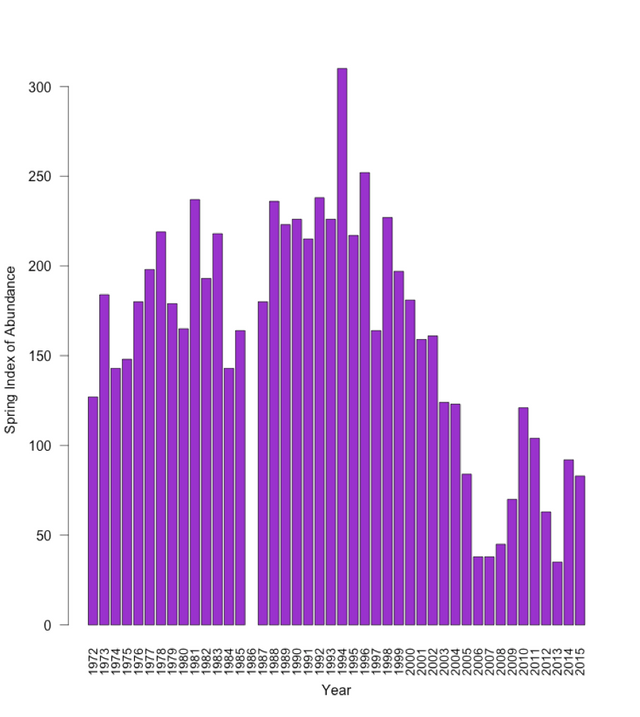 image source
image source
I don't think this chart includes the captive population, which gives us even more reason to be optimistic!
Yeah, I think it's strictly wild population.
I agree with you..they need to be preserved and measures have to put in place to ensure their survival and deter their extinction.
Yep!
Classy.
Nice post @mountainwashere!
They also barfed in the water, left beer cans scattered around, and also left a pair of soiled underwear floating in the water.
You're joking right? This is just making me angry, to imagine that some drunken tourists can literally wipe out a species.
Thankfully they didn't do too much damage, but...
Good read. I am fascinated by these species that inhabit a single micro habitat. Their conservation can often prove a trick dilemma bacause by their very nature they are usually very small players in an ecosystem but I'm glad efforts are being made to conserve them. Just reading and I am happy to see the Ash Meadows Fish Conservation Facility have a decent back up population in their aquariums encase the worst was to happen.
Followed and upvoted. Great post!